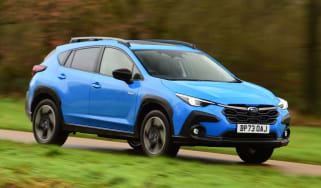Toyota Yaris Cross - MPG, CO2 and running costs
Impressive fuel economy, low insurance rates and decent residuals mean the Toyota Yaris Cross should appeal to cost-conscious family buyers
Low running costs are a particularly strong area for the Toyota Yaris Cross. Along with being relatively cheap to insure and maintaining decent residual values, the petrol-hybrid set-up means that you’ll benefit from superb economy figures and low CO2 emissions.
The Japanese giant claims that the Yaris Cross should return over and above the near 50mpg you’ll typically get from a Ford Puma, with the Toyota hybrid system averaging between 54-64mpg, depending on your chosen specification, and whether you’ve opted for front- or all-wheel drive. We lived with a FWD Yaris Cross in Design trim for several months, during which time it returned an average of 64.7mpg, though it indicated much higher figures on several occasions, so Toyota’s numbers certainly seem to stack up in real-world driving. During our time with the Yaris Cross we spent a lot of time driving on the electric motor alone, without any intervention from us telling the car when to switch from electric to petrol power.
|
Model |
MPG |
CO2 |
Insurance group |
|
Yaris Cross 1.5 Hybrid |
62.8mpg |
107g/km |
11E |
|
Yaris Cross 1.5 Hybrid AWD |
55.4mpg |
115g/km |
12E |
|
Yaris Cross 1.5 Hybrid 130 |
58.9mpg |
109g/km |
14E |
|
Yaris Cross 1.5 Hybrid 130 AWD |
55.4mpg |
115g/km |
14E |
Tax
For company car drivers who aren’t considering a plug-in hybrid or electric car just yet, the entry-level Toyota Yaris Cross Icon model has reasonably low CO2 emissions of 100g/km, which attracts a Benefit-in-Kind tax rate of 25 per cent. Upgrade to the Premiere version and the BiK rate climbs to 27-28 per cent.
Insurance
You shouldn’t need to splash out on insurance cover for the Toyota Yaris Cross. The entry-level Icon model is in group 11 (on the 1 to 50 scale), while all other versions sit in group 12. The more powerful 128bhp versions are in group 14.
In comparison, a 123bhp Ford Puma in ST-Line trim sits in group 12, while the petrol Hyundai Kona with 118bhp will be slightly more expensive to insure because it starts in group 16.
Depreciation
The Toyota Yaris Cross range offers a sliding scale in terms of residual values, with the cheaper Icon model performing the best. After a typical three-year/36,000-mile ownership period, our latest expert data suggests that an Icon model will hold onto around 55 per cent of their original list price, while a top-of-the-range 1.5 Hybrid 130 Premier Edition AWD will see this figure fall to 48 per cent.
For comparison, the Yaris Cross performs just as well as the Ford Puma and Volkswagen T-Cross in terms of residual value over the same period.
To get an accurate valuation on a specific model check out our valuation tool...






